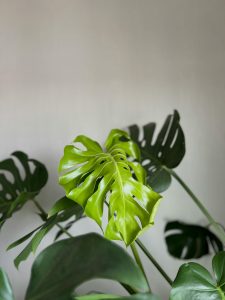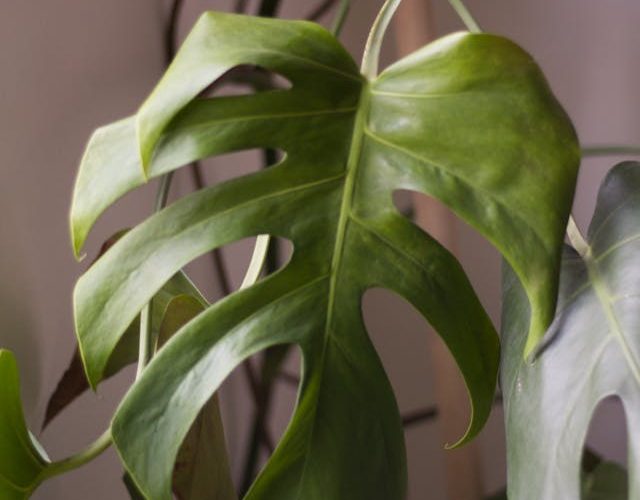When a monstera starts to droop or crisp at the edges, it is sending a message about light, water or roots. The good news is that most issues are easy to correct once you match the symptom to the cause.
Underwatering and water-repellent soil
Crispy tips, curling leaves and a feather-light pot signal drought. Very dry mix can become hydrophobic, so water runs down the sides and bypasses the roots. Bottom water for 20 to 30 minutes until the entire root ball is evenly moist, then drain thoroughly. Return to a steady rhythm, watering when the top few centimetres of mix are dry. Soak through rather than offering frequent sips.
Overwatering and early root rot
Limp leaves with soft brown patches usually mean the opposite problem. Permanently wet mix starves roots of oxygen and invites rot, often alongside a sour smell or fungus gnats. Slip the plant from its pot, trim away mushy roots, and repot into fresh, airy mix in a container with proper drainage. Water only when the top layer has dried and empty saucers after ten minutes so the plant never sits in water.
Too much direct sun
Monsteras like bright conditions but harsh midday or afternoon sun can scorch the leaf surface. Tan or brown patches with a pale halo tend to appear on leaves closest to the window. Move the plant to bright, indirect light or soften the rays with a sheer curtain. Make changes gradually and rotate the pot every few weeks for even growth.

Pexels
Dry indoor air and heat sources
Prolonged low humidity and warm draughts cause browning along edges and tips. Heaters and air conditioning are common offenders. Keep the plant away from vents and radiators, cluster plants to create a slightly more humid pocket of air, and set the pot on a tray of pebbles with water below the base. Prioritise even soil moisture; misting is mostly cosmetic.
Cold draughts and temperature swings
A sudden chill can bruise leaf tissue and turn it brown. Cold glass, open windows and night-time dips are typical triggers. Aim for a steady 18 to 27°C. Pull the pot 30 to 60 cm back from cold windows in winter and keep it out of the path of frequently opened doors.
Pests that sap moisture
Spider mites, thrips and scale puncture leaves and drink sap. Early signs include dull foliage, fine stippling, tiny moving specks and webbing under leaves. Isolate the plant, rinse foliage with lukewarm water, then treat the undersides and stems with a gentle insecticidal soap as directed. Repeat weekly for several cycles to catch new hatchlings. Improve airflow and keep leaves clean to reduce reinfestation.
Fertiliser burn and heavy soil
Over-feeding or a dense, poorly draining mix can burn roots and tip the foliage brown. A white crust on the soil or pot rim suggests salt build-up. Flush the pot with clean water until the runoff is clear, then allow it to drain. Hold fertiliser for at least a month. If the mix is compacted, repot into something lighter – a peat-free houseplant compost loosened with bark and perlite suits aroids and lets water move freely.
Quick care recap
Check moisture with a finger before you water, give bright indirect light, use a pot with drainage and an airy mix, keep temperatures steady and avoid draughts, and inspect leaves weekly for pests. Most brown or wilting monstera leaves trace back to water, light or roots. Correct the environment, tidy any damaged growth, and new leaves should emerge healthy again.
ALSO SEE:
Featured Image: Pexels

